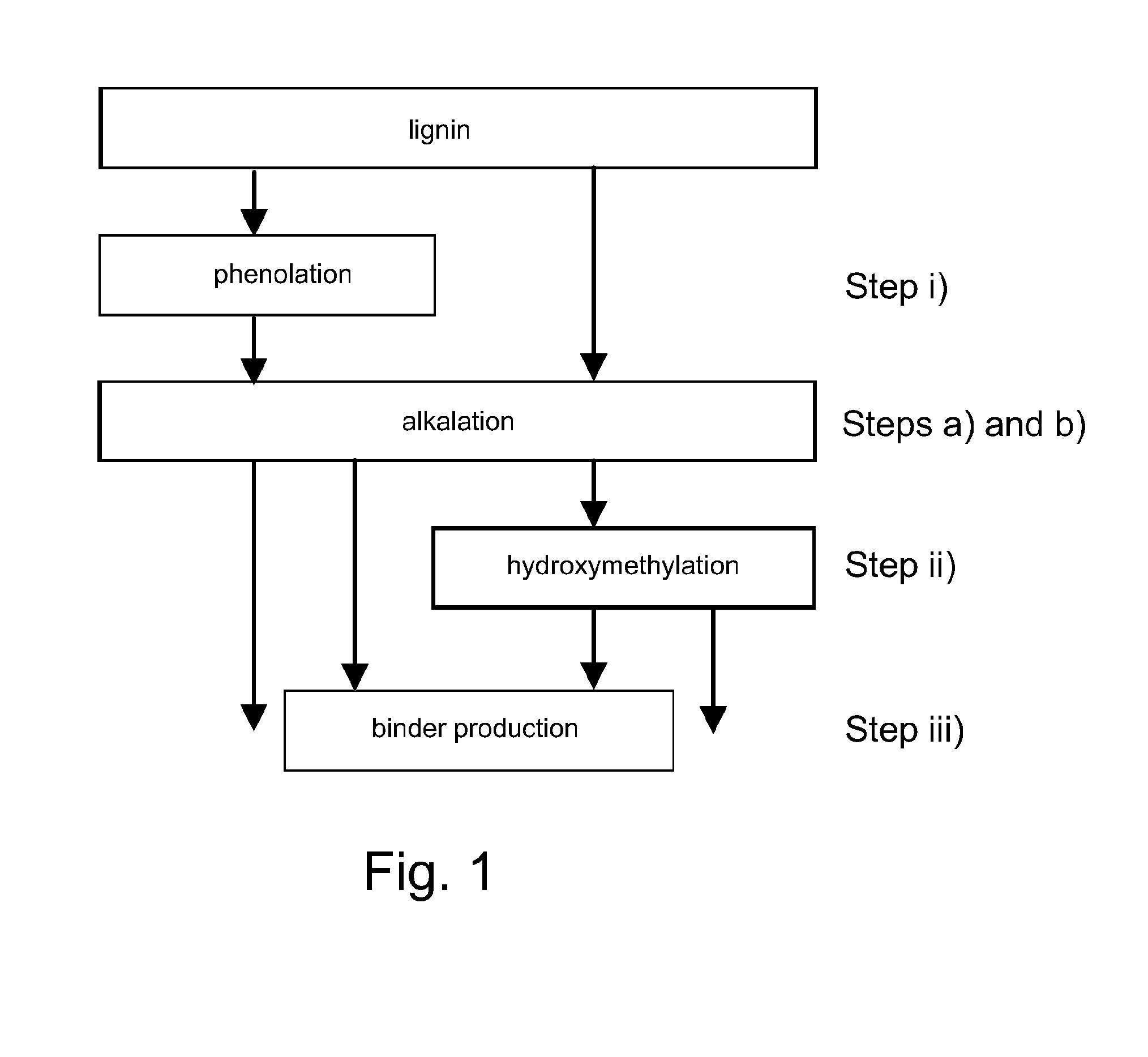A method for increasing the reactivity of lignin
a lignin reactivity and lignin technology, applied in the field can solve the problems of unsatisfactory properties of the produced glue, and achieve the effects of increasing the reactivity of lignin, short dispersing and processing time, and increasing the number of reactive groups
- Summary
- Abstract
- Description
- Claims
- Application Information
AI Technical Summary
Benefits of technology
Problems solved by technology
Method used
Image
Examples
example 1
Alkalation
[0095]In this example the reactivity of lignin was increased by alkalating the lignin. The following components and their amounts were used:
concentrationamount (g)water836NaOH50%584lignin75%1270
[0096]Firstly, water and NaOH were mixed and heating of the mixture was started. Then lignin was added into the mixture of alkali and water with agitation and simultaneously the temperature was increased up to 80° C. When the lignin had been added, the mixture was heated at a temperature of about 85° C. for 45 minutes.
[0097]Lignin treated in accordance with Example 1 was thereafter used for producing a binder composition. 38 g of phenol (90%) were mixed with 105 g of alkalated lignin, after which 79 g of formaldehyde (37%) was added in a stepwise manner. NaOH was used as catalyst. The temperature was kept under 75° C. Thereafter the cooking was continued at 85-90° C. until the viscosity of the formed composition was about 415 cp (as measured at a temperature of 25° C.).
example 2
Alkalation, Low Temperature
[0098]In this example the reactivity of lignin was increased by alkalating the lignin. The following components and their amounts were used:
concentrationamount (g)water836NaOH50%584lignin75%1270
[0099]Firstly, water and NaOH were mixed and heating of the mixture was started. Then lignin was dispersed slowly into the mixture of alkali and water with agitation and simultaneously the temperature was increased up to 77° C. When all of the lignin had been dispersed, the dispersion was heated at a temperature of about 60° C. for about 1 hour. As a result the lignin became alkalated.
example 3
Alkalation, High Temperature
[0100]In this example the reactivity of lignin was increased by alkalating the lignin. The following components and their amounts were used:
concentrationamount (g)water836NaOH50%584lignin75%1270
[0101]Firstly, water and NaOH were mixed and heating of the mixture was started. Then lignin was dispersed slowly into the mixture of alkali and water with agitation and simultaneously the temperature was increased up to 71-77° C. When all of the lignin had been dispersed, the dispersion was heated at a temperature of about 90-95° C. for about 1 hour. As a result the lignin became alkalated.
[0102]Lignin alkalated according to Example 2 and Example 3 were tested for their formaldehyde reactivity. The formaldehyde reactivity was determined according to the method described in publication Wooten A. L., Sellers T., and Tahir P. M., Reaction of formaldehyde with lignin, Forest Products Journal 38(6):45-46, 1988. Firstly alkalated lignin formed according to Example 2 and...
PUM
| Property | Measurement | Unit |
|---|---|---|
| temperature | aaaaa | aaaaa |
| temperature | aaaaa | aaaaa |
| temperature | aaaaa | aaaaa |
Abstract
Description
Claims
Application Information
 Login to View More
Login to View More - R&D
- Intellectual Property
- Life Sciences
- Materials
- Tech Scout
- Unparalleled Data Quality
- Higher Quality Content
- 60% Fewer Hallucinations
Browse by: Latest US Patents, China's latest patents, Technical Efficacy Thesaurus, Application Domain, Technology Topic, Popular Technical Reports.
© 2025 PatSnap. All rights reserved.Legal|Privacy policy|Modern Slavery Act Transparency Statement|Sitemap|About US| Contact US: help@patsnap.com

